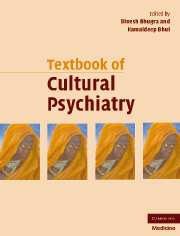Book contents
- Frontmatter
- Contents
- Contributors
- Foreword
- Preface
- Part I Theoretical background
- 1 Cultural psychiatry in historical perspective
- 2 Anthropology and psychiatry: the contemporary convergence
- 3 Suicide, violence and culture
- 4 Psychology and cultural psychiatry
- 5 Spirituality and cultural psychiatry
- 6 Culture, ethnicity and biological psychiatry
- 7 Ethnic inequalities and cultural capability framework in mental healthcare
- Part II Culture and mental health
- Part III Culture and mental disorders
- Part IV Theoretical aspects of management
- Part V Management with special groups
- Part VI Cultural research and training
- Cultural psychiatry: the past and the future
- Index
- References
6 - Culture, ethnicity and biological psychiatry
from Part I - Theoretical background
Published online by Cambridge University Press: 11 August 2009
- Frontmatter
- Contents
- Contributors
- Foreword
- Preface
- Part I Theoretical background
- 1 Cultural psychiatry in historical perspective
- 2 Anthropology and psychiatry: the contemporary convergence
- 3 Suicide, violence and culture
- 4 Psychology and cultural psychiatry
- 5 Spirituality and cultural psychiatry
- 6 Culture, ethnicity and biological psychiatry
- 7 Ethnic inequalities and cultural capability framework in mental healthcare
- Part II Culture and mental health
- Part III Culture and mental disorders
- Part IV Theoretical aspects of management
- Part V Management with special groups
- Part VI Cultural research and training
- Cultural psychiatry: the past and the future
- Index
- References
Summary
EDITORS' INTRODUCTION
The differences between universalist and relativist positions related to pharmacological interventions are of great interest to researchers and clinicians alike. The variations in social forces and cultural traditions and attributed similarities are proofs of the universality of the biological processes underlying psychiatric problems. Regional and ethnic variations almost always exist and associated biological and social factors must be considered in managing patients. Chen and colleagues, in this chapter, highlight the interface between biological psychiatry and neurosciences on the one hand and culture and ethnicity on the other. They raise three issues on the subject – those of generalisability, variations in groups and individuals and finally the theoretical implications embedded in cross cultural research is commonly observed and well documented. Beside genetic predispositions, it also stands to reason that influences of culture on biological processes could also lead to disease susceptibility. Biological markers responsible for disease and response to medication have not been studied in all cultural and ethnic groups. Biology is not culture free, and the complex interaction between culture and biology includes genetic vulnerability and resilience related to environmental factors. People with different ethnic and ancestral backgrounds have different genetic profiles, which may indicate differential risks for specific disorders.
Physical and social milieus within which people live are shaped by cultural factors, thus the interaction of biology and culture shapes responses and outcomes in various psychiatric disorders.
- Type
- Chapter
- Information
- Textbook of Cultural Psychiatry , pp. 72 - 80Publisher: Cambridge University PressPrint publication year: 2007
References
- 1
- Cited by



